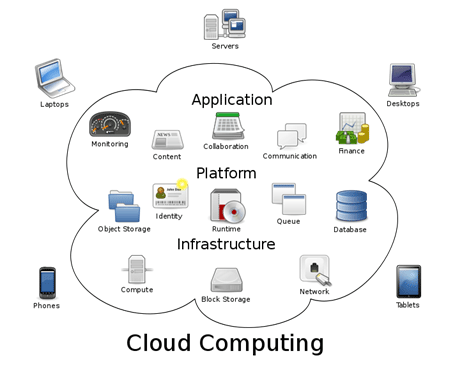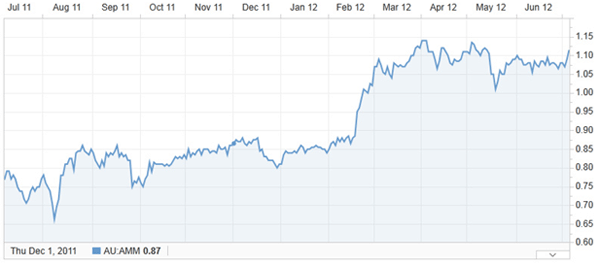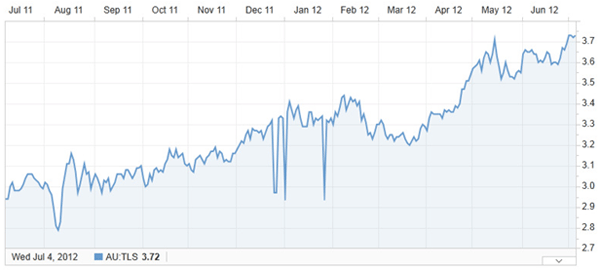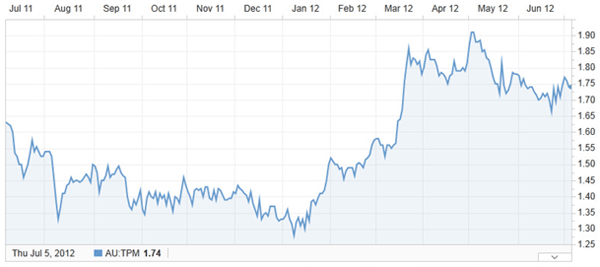The concept has been floating around for decades but only in recent years have the nebulous computing clouds become apparent to the average person. What is cloud computing and how might it change the way we go about business? Is it a good trend to invest in?
What Is Cloud Computing?
Random House Dictionary defines ‘cloud computing’ as “Internet-based computing in which large groups of remote servers are networked so as to allow sharing of data-processing tasks, centralized data storage, and online access to computer services or resources.” What does that mean in lay-mans terms?
It used to be that if you started a big business you needed to invest heavily in computers, a room full of hard-drives to store and back up all your data, servers to run the programs, teams of IT guys to maintain it all. With cloud computing, this model is largely becoming a way of the past. Think of it as outsourcing all your computing needs where all the above is run by another party at a remote location. You log-in to the Internet or a private network on a server somewhere else in the world running a program that your company needs with the data saved on their hard-drives which are maintained by their people. And this information can be accessible by desktop, laptop, tablet computer or smartphone.
This allows many businesses to lower costs as their computing needs are much like electricity having only to pay for what they use. The trend is all about economizing the use of computer hardware, software, networks and people to run it.
Cloud Computing Diagram – by Sam Johnston

Cloud Computing Components
The main idea is to have all our computing needs – both hardware and software – run remotely by another party while having it easily accessible at all times. This saves company time and money as well as fully utilizing the usage of the cloud computing company. What are the basic components of cloud computing?
Software and Services on Demand – Instead of buying a program on a CD, loading it into your servers with multi-licenses for your business, you simply log into the program typically via the Internet and use the software as a service. This can also include other services (not only applications) such as credit card processing. At other times, the end user many not even be aware, or have access to, the programs and services running… such as a security service that scans e-mails and other data for viruses.
Infrastructure/Platform Usage – Perhaps your company does not need a specific piece of software or ready-made service, but instead need use of a platform to build their own apps. Cloud computing allows you to make use of a developer platform to create your own customized solution. Or perhaps the company is simply looking for a large infrastructure that can handle many different operating systems and computers plugging in from all over the place – a flexible portal for the business to meet. This is another massive use of the cloud.
Data Storage – Need a backup of your business data in case the ‘in-house’ computers fail? While many businesses are apprehensive to put sensitive information into the ‘cloud’ with ‘breach of security’ fears (whether properly founded or not), there are many other viable uses for utilizing massive remote storage banks. And there could be a trend towards putting increasingly critical data into the cloud in time.
Cloud Computing Trends
While the concept of cloud computing is novel, will it be trivial or increasingly prevalent? When considering some of the practical applications of cloud computing – it appears that many aspects of it will become a trend while other areas may decrease in significance. Consider a few areas:
Security – While economising resources is a major perk of cloud computing, keeping that data safe is vital for corporate clients and others. Companies on the cutting-edge of security, particularly as it relates to cloud computing, should be a growth industry.
Mobile Cloud Computing – Not too long ago the laptop was contending for the mobile computing solution. Now with a plethora of smartphones, tablet computers and everything in between, the need for mobile access to the cloud may be big business on small devices.
Efficiency and Economising – Because cloud computing has adopted a ‘pay per use’ ideal much like public electricity, it is in the company’s best interest to reduce that usage to keep the bill down. Finding ways to compress or optimize data will produce lower cloud costs, much like lowering the thermostat and putting in efficient bulbs saves on electricity.
Backup – Whether it be an environmental disaster or some other problem that creates an outage, more businesses should see the value in having a remote back-up to limit downtime.
Platforms – It seems reasonable that product development platforms should see increased traction as the computing community continues to embrace the use of focused, light-weight apps. These cloud-based platforms allow people anywhere to have access create a marketable product for retail.
Cloud Markets
What is the global market forecast for cloud computing? Some forecasts were posted on the Softwarestrategiesblog.com, which makes reference to a study by Gartner. The blog breaks down the forecast into the following key areas:
- Business Process – a 15% compound annual growth rate over the next 4 years. The top performing sub-groups for growth are Payments, Advertising and Industry Operations.
- Application Services/Software – a 17.4% compound annual growth rate is expected over the next 4 years. The sub-groups that are expected to out-perform the rest are Office Suites (40.7%) and Digital Content Creation (27.1%).
- Application Infrastructure/Platforms – this global segment could see a 27% compound annual growth rate over the next 4 years.
- System Infrastructure Services – this is the area of peak growth over the short-term with a projected compound annual growth rate of 41.7%.
- Management and Security – a CAGR of 27.2% is anticipated over the next few years in this field of cloud computing.
Global and Australian Markets
The beauty of cloud computing is that the firm offering services need not reside in the country of use. This allows for global cloud service providers. Some of the larger players in the worldwide marketplace are as follows:
- Amazon (AMZN)
- Google (GOOG)
- IBM (IBM)
- Microsoft (MSFT)
- Salesforce.com (CRM)
There are also a wide variety of Australian companies offering a variety of cloud computing solutions (Companies with codes are ASX listed):
- 6YS
- Amcom Telecom (AMM)
- Anittel
- Apexhost.com
- Aptus
- ASG Group
- Big Noise Group
- Brennan IT
- Cloud Central
- Datacom
- iiNet (IIN)
- Interactive
- Macquarie Telecom (MAQ)
- ManageNET
- Melbourne IT (MLB)
- Professional Advantage
- Reseau
- Telstra (TLS)
- Virtual.Offis
- WCS
- Web.drive
- Zettagrid
- Vocus Communications Limited (VOC)
- Reckon Limited (RKN)
- Xero FPO NZ (XRO)
- Global Health Limited (GLH)
Is Australia positioned or interested in being a major player in this market-space? The 2011 paper, The potential for cloud computing services in Australia (pdf) notes the following:
Cloud computing was worth an estimated $1 billion in 2010 with an associated 4,300 jobs. Macquarie Telecom, Fujitsu and Telstra have invested nearly a combined $1 billion at the time of this report showing that some big players see potential in Australia. What might drive regional and global business to Australia’s cloud offerings?
Cloud Security and Stability
How safe your cloud data and services are depends not only on the physical hardware and software but also on the country that the servers are situated in. For example, there should be political and institutional stability where riots or policy changes do not interfere with the running of your business elsewhere. Australia has such stability.
How secure is your data? The United States Patriot Act gives the US government right to any part of the cloud to which it feel it has jurisdiction. Many businesses feel this to be a violation of their privacy and may look elsewhere to store their sensitive data. How does Australia fare in this regard? With the goal of protecting their own interests, the Australian government does not allow its own agencies to hold personal information offshore. This may encourage firms in other countries to follow suit in what they perceive as a safe haven for their information.
Difficulties to Overcome
However, despite these upsides there is the physical limitations imposed by Australia’s location. Being remote and surrounded by water creates issues relating to bandwidth and latency for firms located far away. In addition to this there is the issue of a high dollar against many currencies which can make Australia’s cloud computing relatively more expensive than countries with a lower valued currency.
Interestingly, the latency issue relating to off-shore delays in data transmission also make local cloud computing services more attractive for Australians. It keeps local customers using local business. And this may simply mean that Australian cloud services may need to target areas of the market where low latency is not a priority.
Investing in Cloud Computing Companies (Australian)
With high global growth in cloud computing, Australia’s strong regional positioning and a potential to be a ‘safe haven’ for data globally, it makes sense to look a little closer at some of the investment opportunities in Australian cloud computing. Which firms are well positioned for growth and have good value right now? Consider a few firms worthy of consideration.
Amcom Telecommunications (AMM)

Amcom is primarily a provider of fiber and DSL services and more recently IP Systems for packaged solutions. While having strong revenues and growth from their fibre division, there is high potential upside for the many other business services that can be added on through cloud, managed services and VOIP.
Zacks shows analysts have high hopes for the stock as 5 rate it a strong buy and 1 a moderate buy. Earnings are expected to grow by 26% in 2013 and revenue by the same amount. This company is well-positioned towards the on-going trend of mixing information technology services and telecommunication companies. They expect another year of double-digit earnings growth for the current FY and a decent dividend payment (1.8 cents fully franked interim) while you wait. The yield currently sits at 4.49 and I rate this a decent buy for the future of cloud computing.
Telstra (TLS)

Telstra is considered the giants in the industry. They are transferring their copper-wire network and its customers to Australia’s National Broadband Network (NBN). They continue to build their wireless network and strengthen the balance sheet as they position themselves well for future trends. The strong generation of cash flow, being a leader in mobile, fixed-line and pay TV and forging ahead with new technology makes this a titan worthy of respect.
With a 28 cents per share fully franked dividend expected, that equates to a 7.5% dividend yield. The company is expected to grow at a 12.64% annual rate over the next 5 years – although these sorts of long-term estimates are often inaccurate. A strong yield, healthy positioning and big cash flows from NBN payments make Telstra a solid choice.
And as for cloud computing? Their Network and Application Services (NAS) is where the cloud comes into play. Managed network services is growing strong and some think that the NAS division may be able to generate up to $2 billion in 5 years. Cloud computing is expected to grow as the 2,000 square metre data center in Melbourne has an anticipated on-line date in 2013 which should create 40$ more capacity for the firm.
Telstra is currently increasing shareholder value primarily through dividends and wise use of cash as they plan to be a leader for the long haul. This is a good buy over the next few years and one of the safer bets (in my opinion) among Australian cloud firms. The hefty dividend now helps lower the long-term risk along the way.
TPG Telecom (TPM)

TPG Telecom is the a giant in its own rights having the second largest data network and voice network and the largest bundled services of voice/video/data IP services in Australia. They are a leader in second tier broadband subscribers. TPG continues to acquire smaller companies (PIPE Networks and Trusted Cloud), have a competitive costs, and decent offerings for consumers that should enable on-going bottom line growth.
However, despite having a toe-hold in the cloud computing department, it should be noted that TPG has stiff competition from Telstra. It may require TPG focusing on small to medium sized businesses or the government sector to expand. These deals don’t come quickly but when acquired, the on-going revenue streams can be sweet.
The first half-year results of 2012 look promising when compared to the first half of last year as revenue grew 17% and earnings grew 61%. Based on 2013’s expected earnings, the shares currently have a forward P/E ratio of 9.59. While the dividend yield is a lowly 2.84%, it should be noted that the payout ratio is also low at 39% and much of the earnings and cash will be to promote growth, unlike Telstra’s plan of slower steady growth while returning value primarily through dividends.
While some prefer to look for deeper value, we feel that strong growth prospects make TPG a good complimentary stock pick in conjunction with Telstra and Amcom for a cloud computing trio.
Summary
While some trends are here today and gone tomorrow, the move towards economy and utilization of computing storage, power and programs appears to be a logical evolution of the digital age. Instead of hiring local experts and buying huge amounts of infrastructure, companies are able to buy only what they use from a remote location that specialises in all things IT. As more businesses see the value in cloud computing, this will increase demand in key areas such as infrastructure, security and platforms for developing apps to name just a few.
Australia does have some hurdles to jump over to be a global provider, but government regulations should promote regional business and even off-shore firms wanting an information ‘safe haven’ where latency is not a major factor. This report outlines just three cloud computing firms in Australia but there are many more companies referenced (and some not referenced) that could be good investments in this industry as well.